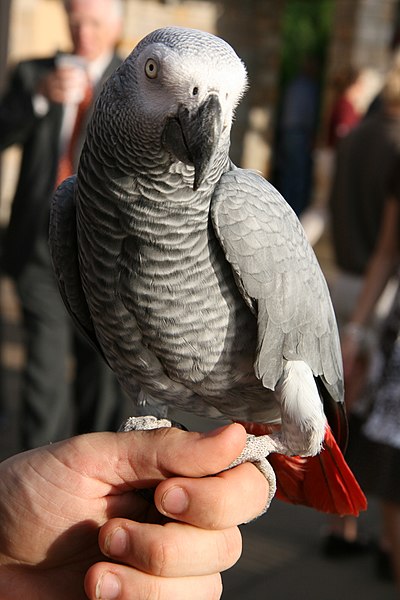 Like many parrot owners, I’ve tried just about everything possible to teach my birds to speak – repetition, “mentor birds”, training CDs, begging and pleading, and so on. A recent article in The Journal of Neuroscience (Jan. 2010) has added a new technique – a good night’s sleep!
Like many parrot owners, I’ve tried just about everything possible to teach my birds to speak – repetition, “mentor birds”, training CDs, begging and pleading, and so on. A recent article in The Journal of Neuroscience (Jan. 2010) has added a new technique – a good night’s sleep!
Sleeping and Speaking
Just as with people, a full night of undisturbed sleep has been shown to greatly improve the ability of European Starlings (Sturnus vulgaris) to remember what they learned during the day. I’m particularly interested in this because, in my experience, the much-maligned Starling (note the Latin name – vulgaris!) is actually just as intelligent and curious as most parrots.
In fact, unbeknownst to most folks, Starlings can mimic human words quite well. An injured Starling kept at the American Museum of Natural History was a childhood favorite of mine. The museum’s unofficial mascot, it lived there for many years and delighted all with its impressive vocabulary.
Your Parrot’s Night
Parrot owners sometimes overlook the importance of sleep. Most parrots are native to tropical regions, that where nights average 12 hours in length year round. Our own long days and short nights do not suit them well (nor us, it seems!).
Attention should also be given to your parrot’s quality of sleep…easily-missed disturbances such as passing cars, a cat at the window or lights from other buildings can disturb its sleep and contribute to health or behavioral problems and, it appears, learning abilities.
Implications for People
Interestingly, much of what was observed by working with Starlings seems applicable to people as well. It is hoped that further work in this area will offer insights into how our brains retain (or fail to retain!) knowledge.
Until then, try letting you parrot sleep more and please report back with your results!
Further Reading
If you doubt my “Talking Starling Story”, please check out this video of a very talented Starling.
For more on parrot training, please see Parrot Tricks: Where do I Start?
 That Bird Blog – Bird Care and History for Pet Birds
That Bird Blog – Bird Care and History for Pet Birds


Great information that I never really thought of before. I also found out that keeping training sessions to around 15 minutes really helped out also. You think they will never get a word and then one day they just start saying it. Really is amazing.
Hello, Frank Indiviglio here.
Thanks for your interest in our blog and the kind words.
I agree – I’ve not run across many birds that did not start to “wander” after 15 minutes (happened even quicker when I was teaching biology to 12 year olds!).
Good luck and please check in from time to time,
Best regards, Frank Indiviglio.
I noticed that when my aggressive Jenday male, Pretty Boy, started getting 12 hours of uninterupted sleep(in the closet of all places), he became a lot sweeter. He didn’t bite as much or as hard, he was more willing to be petted and handled. All around, it really helped his mood out and our relationship has really grown. Instead of being my little agressive boy he became my little sweet boy, at least with me anyway. He is getting better with other people.
Hello Annie, Frank Indiviglio here.
Thanks for your interest in our blog and the feedback – very happy to hear your good news. It’s very useful for myself and our readers to learn of each other’s experiences…especially so in this case, because parrot behavior is such a complicated topic – nice to have a simple solution once in awhile…incidentally, I was plagued by sleeping problems for years – since resolving them, I’m told my personality has also improved!
Good luck and please keep me posted.
Best regards, Frank Indiviglio.
Hey, you should check this out: http://www.youtube.com/watch?v=SahrLcLLfdA It’s Connor doing her big and scary act! It’s darling! If the link doesn’t come through, seach nonskids bird. Watch Robert’s Big and Scary video. Just wanted to share it with you!
Hello Annie,
Thanks very much for the link ….I hope everyone enjoys!
Till next time,
Best regards, Frank Indiviglio.
My 14 year old African Grey gets about 10 hours of sleep a night. His cage is in a quiet room with an air cleaner. My husband thinks the noise of the air cleaner is keeping him awake but I believe it helps block out other noise plus he should be use to it by now since we’ve had this set up for over 7 years. What is your opinion and do you think I should be putting him to bed earlier?
Hi Lori,
12 hours is usually given as the standard, and considering the Af gray’s natural range that would be close to what they are adapted to. However, 10 is not bad, but you might try extending it if possible. In zoos we use background noise for sensitive creatures…naked mole rats come to mind, although I don;t recall any bird examples. probably fine; might take some adjustment if you shut it at summer’s end. Best, Frank